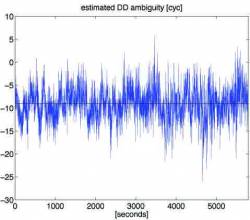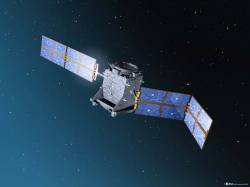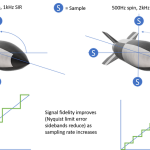 GIOVE-A/B Double Difference Ambiguity Measurements, TU Delft
GIOVE-A/B Double Difference Ambiguity Measurements, TU DelftResearchers at Delft University of Technology (TU Delft), the Netherlands, succeeded this week in simultaneously tracking the GIOVE-A and GIOVE-B L1 Open Service signals in space, producing the first reported computation of a double-difference carrier phase integer ambiguity resolution on the first two experimental Galileo satellites in orbit.
Researchers at Delft University of Technology (TU Delft), the Netherlands, succeeded this week in simultaneously tracking the GIOVE-A and GIOVE-B L1 Open Service signals in space, producing the first reported computation of a double-difference carrier phase integer ambiguity resolution on the first two experimental Galileo satellites in orbit.
Beginning at 20:12 UTC on July 6, the researchers collected simultaneous ranging measurements to 12 GPS satellites, two geostationary European Geostationary Navigation Overlay Service (EGNOS) satellites, and to two Galileo satellites, GIOVE-A and GIOVE-B.
(NOTE: More detailed information about this research will be available in a technical article in the September-October 2008 issue of Inside GNSS)
A short baseline of a few meters between two identical receivers was set up in the flat and open Delfland area, allowing for a clear reception of the various GNSS signals in space. The measurements, across two Galileo satellites and two receivers, enabled them to form a pure Galileo double-difference. Using the geometry-free approach, the GIOVE-A–GIOVE-B carrier phase cycle double difference ambiguity can be estimated using the pseudorange code measurements.
The accompanying graph shows, for the full joint visibility duration of GIOVE-A and GIOVE-B (96 minutes), the epoch-wise ambiguity estimates. The empirical standard deviation is 3.4 cycles (on L1), which reflects the double difference pseudorange code noise.
According to the researchers, the overall (averaged) ambiguity float estimate is -9.05, which is fixed with large confidence, to the integer value -9. The carrier phase measurements of both GPS and Galileo were found to have similar precision, around 1–2 millimeters (standard deviation; undifferenced).
This achievement was reached in close cooperation with Septentrio Satellite Navigation in Leuven, Belgium. Researchers included Christiaan Tiberius and Hans van der Marel, at TU Delft, and Jean-Marie Sleewaegen and Frank Boon, of Septentrio.
The measurements were collected using two AsteRx1 L1 24-channel GNSS receivers with firmware that allows tracking of the Open Service L1-BC signal of Galileo GIOVE-A and GIOVE-B.





